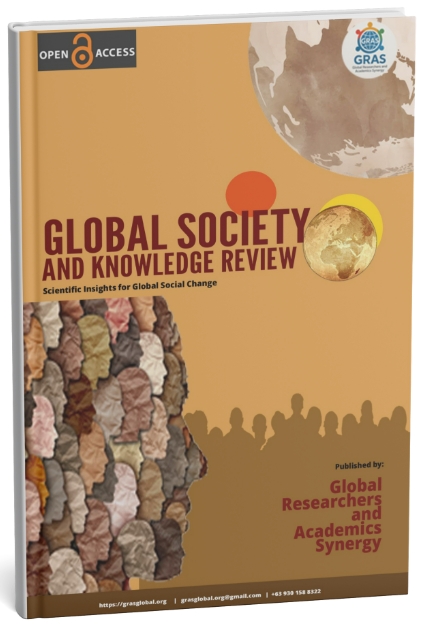Enhancing Disaster Resilience in Coastal Bangladesh through Local Mapping Initiatives
Keywords:
disaster resilience, participatory mapping, coastal Bangladesh, community-based disaster risk reductionAbstract
Coastal Bangladesh faces unprecedented challenges from climate-induced disasters, necessitating innovative approaches to disaster risk reduction that integrate local knowledge with scientific methodologies. This study examines the effectiveness of participatory mapping initiatives in enhancing disaster resilience among coastal communities. Through systematic analysis of community-based mapping programs, vulnerability assessment methodologies, and participatory Geographic Information Systems (GIS) applications, this research demonstrates how local mapping initiatives contribute to improved disaster preparedness, risk communication, and adaptive capacity. The findings reveal that participatory mapping approaches effectively bridge the gap between scientific risk assessment and community perception, enabling more targeted and culturally appropriate disaster risk reduction strategies. Local mapping initiatives enhance community ownership, improve early warning systems, and facilitate evidence-based decision-making at the grassroots level. The integration of traditional knowledge with modern mapping technologies creates comprehensive risk profiles that inform both immediate response strategies and long-term resilience planning in coastal Bangladesh.
Downloads
References
Ahmed, S., Rahman, M. S., & Hossain, M. A. (2024). Climate-induced displacement and community resilience in coastal Bangladesh: A participatory mapping approach. International Journal of Disaster Risk Reduction, 98, 104125. https://doi.org/10.1016/j.ijdrr.2024.104125
Alam, K., & Ray-Bennett, N. S. (2023). Disaster risk governance and gender in Bangladesh: The role of social protection. International Journal of Disaster Risk Reduction, 87, 103568. https://doi.org/10.1016/j.ijdrr.2023.103568
Bhuiyan, M. A. H., Siwar, C., & Ismail, S. M. (2024). Developing a disaster risk index for coastal communities in southwest Bangladesh: Shifting from data-driven models to holistic approaches. Ecological Indicators, 159, 111678. https://doi.org/10.1016/j.ecolind.2024.111678
Ferdous, J., Mallick, D., & Matin, N. (2023). Multi-level learning in reducing disaster-risk and building resilience to cyclones in coastal Bangladesh. International Journal of Disaster Risk Reduction, 91, 103694. https://doi.org/10.1016/j.ijdrr.2023.103694
Habib, M. A., Shahidullah, S. M., & Ahmed, D. (2024). Assessing critical infrastructure resilience in terms of its service-providing capacity in coastal Bangladesh: A synthesis of geospatial techniques and social responses. International Journal of Applied Earth Observation and Geoinformation, 116, 103167. https://doi.org/10.1016/j.jag.2023.103167
Hassan, M. K., Southworth, J., & Mollah, M. R. (2024). A framework for appraising the status of disaster resilience within the multi-hazard environment of coastal Bangladesh. International Journal of Disaster Risk Reduction, 102, 104289. https://doi.org/10.1016/j.ijdrr.2024.104289
Hossain, M. S., Gadagamma, C., & Bhattacharya, Y. (2023). Households' vulnerability assessment: Empirical evidence from cyclone-prone area of Bangladesh. Geoscience Letters, 10, 28. https://doi.org/10.1186/s40562-023-00280-z
Islam, M. R., Ingham, V., Hicks, J., & Kelly, E. (2024). Resilience of coastal communities to climate change in Bangladesh: Research gaps and future directions. Regional Environmental Change, 24, 87. https://doi.org/10.1007/s10113-024-02098-4
Khan, M. S. A., Hoque, M. A., & Rokonuzzaman, M. (2023). Coping with disasters: Changing patterns of disaster risk reduction activities in the southwestern coastal areas of Bangladesh. International Journal of Disaster Risk Reduction, 95, 103847. https://doi.org/10.1016/j.ijdrr.2023.103847
Mallick, B., Sultana, Z., & Bennett, C. M. (2024). Coastal disaster risk management in Bangladesh: Vulnerability and resilience perspectives. Ocean & Coastal Management, 241, 106689. https://doi.org/10.1016/j.ocecoaman.2024.106689
Muhsyanur, M. (2023). The Bugis People’s Naming System in Bugis Ethnic Tradition. Journal of Language and Literature, 23(1), 67–76. https://doi.org/10.24071/joll.v23i1.5062
Patwary, M. S. H., & Uddin, M. S. (2023). GIS based mapping of vulnerability to earthquake and fire hazard in Dhaka city, Bangladesh. International Journal of Disaster Risk Reduction, 89, 103621. https://doi.org/10.1016/j.ijdrr.2023.103621
Rahman, M. A., Hossain, M. S., & Chakraborty, T. R. (2024). Exploring local perspectives on flood risk: A participatory GIS approach for bridging the gap between modelled and perceived flood risk zones. Applied Geography, 164, 103205. https://doi.org/10.1016/j.apgeog.2024.103205
Roy, C., Sarkar, S. K., & Åberg, J. (2023). Community resilience to cyclone disasters in coastal Bangladesh: A vulnerability to resilience approach. Sustainability, 15(4), 3542. https://doi.org/10.3390/su15043542
Sultana, N., Rayhan, M. I., & Ahsan, M. N. (2024). A parsimonious approach to mapping climate-change-related composite disaster risk at the local scale in coastal Bangladesh. International Journal of Disaster Risk Reduction, 98, 104087. https://doi.org/10.1016/j.ijdrr.2024.104087
Tschakert, P., Dietrich, K., & Tamminga, K. (2024). Integrating knowledge and actions in disaster risk reduction: The contribution of participatory mapping. Disasters, 48(2), 456-478. https://doi.org/10.1111/disa.12589
Downloads
Published
Issue
Section
License
Copyright (c) 2025 Kavita Mehra, Farezh Naha, Hoolo Ramaye Ramesh, Maya Juwidhi Delta (Author)

This work is licensed under a Creative Commons Attribution-ShareAlike 4.0 International License.













